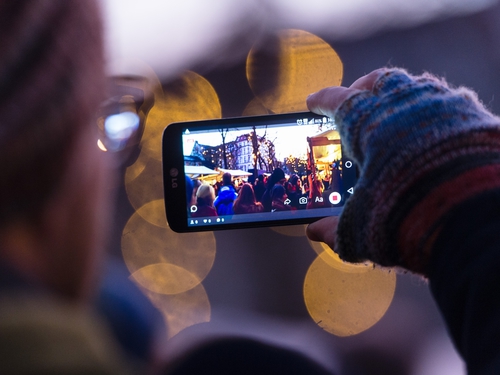
Live videostreams get lots of views if you film events. – dpa File Photo
Live video streaming isn’t rocket science. Those who want to spontaneously share what they are seeing or experiencing with others can get started right away – with Facebook Live, for example.
Gavin Karlmeier, social media editor at public broadcaster WDR, says its usability, functionality and reach are distinct advantages.
“Just click on the ‘Live’ button in the app on your tablet or smartphone – and you’re on.”
Even on the technical side of things, there aren’t many things you have to think about, says Karlmeier, who streams a weekly live show on his Facebook page.
“In my opinion, good lighting and avoiding ambient noise should basically do the trick.” The content is what it’s really about after all. “You should keep in mind that a selfie camera mirrors the image,” says the expert. “This means that if you hold up a written piece of paper into the camera, the audience will see it mirrored and be unable to read the writing.”
Of course, not every smartphone produces equally good videos, says Daniel Fiene, head of editorial digital strategy at the newspaper Rheinische Post.
“Videos taken with premium smartphones will usually look better because the camera is of higher quality.” Fiene believes that a sensible microphone, capable of delivering decent sound during a live stream, may even be more important.
Professional image quality can’t be produced by smartphones and without substantial technical resources, the expert says.
The internet has also changed the viewing habits of many people anyway.
But how do you reach your viewers? It is important to consider various things when it comes to increasing the reach, says Soeren Steinmann, owner of a company for streaming services and consulting in Herford, Germany.
The decision as to which platform to use should be considered carefully beforehand.
“While you can only reach your own contacts and followers on Facebook, people who aren’t personally associated with the producer can also watch your videos on YouTube,” explains Steinmann. Twitter’s streaming app Periscope can potentially enable you to reach many viewers.
The main prerequisite for a successful stream remains interesting content. A private party may perhaps be exciting for your relations and friends, but will hardly be of interest to the general public. The place where the stream is being recorded can also increase the number of viewers.
“The more interesting the location, the more exciting the stream is for the audience,” says Steinmann. And, of course, the personality and aura of the presenter also play an important role.
Whether via Twitter or Facebook: Announcing a stream in advance is important – and it’s best to include the topic and content at the same time, says Gavin Karlmeier.
“Announcing how long – or rather brief – the stream will be, can stir some interest,” says the expert. Lengthy streams should be avoided.
At the end of the day, however, you won’t be really able to tell beforehand what’s going to work and what isn’t.
“One of the most successful streams was that of an American woman named Candace Payne, who was simply wearing a Chewbacca mask and had to laugh out loud,” Daniel Fiene says. But sometimes a stream can gain traction, while it’s already running. “It can help to repeatedly animate the viewers to share in order to expand your own audience.”
When it comes to content, it’s important to keep potential copyright issues in mind – and to stay away from protected music.
“The live stream of Facebook even contains an algorithm that blocks the broadcast when protected music is detected,” Fiene says.
Things aren’t always that straightforward, though, even when it comes to your own copyrights, because, in theory, Facebook and YouTube can do whatever they want with the content streamed through their services. That’s what it says in their terms and conditions.
However, there’s no need to panic. The main reason you have to waive your rights is so that the providers have the permission to publish the content in the first place, explains Steinmann.
“Usually, however, these platforms won’t act against the users’ wishes, because they depend on the goodwill of their users.” So far, no case has been made public in which content has ever been published against a user’s will. – dpa
